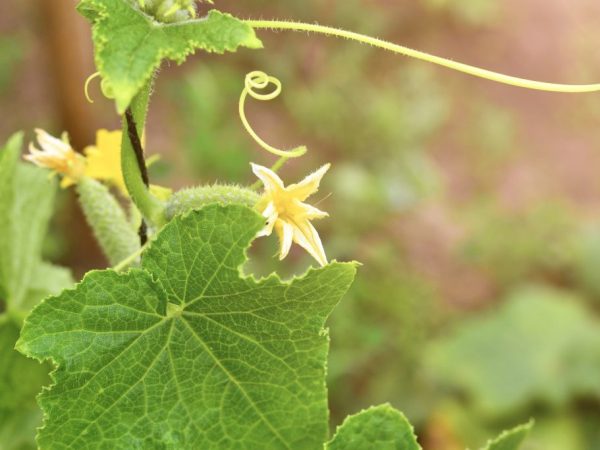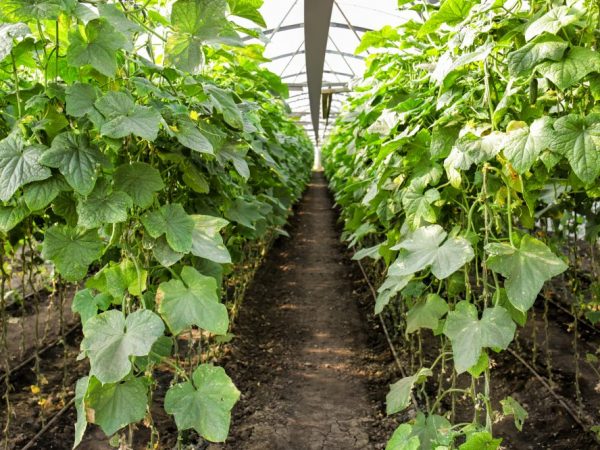How to spray cucumbers with hydrogen peroxide
An important part of the concerns of summer residents and gardeners in caring for cucumbers is the prevention and treatment of diseases, and pest control. In specialized stores there is a large assortment of all kinds of chemicals for these purposes. But more and more popular are funds that are generally available and harmless to humans. So, recently, vegetable growers have been using hydrogen peroxide to spray cucumbers.

Spraying cucumbers with hydrogen peroxide
It can be watered with plants, used for the treatment of seeds, soil. Some people think that this is a great food for vegetables.
Feature of the effect of hydrogen peroxide
Hydrogen peroxide (hydrogen peroxide) is a colorless substance with a "metallic" taste, which is of natural origin. It is found in atmospheric precipitation and is a by-product of the oxidation of various substances by air. Contained in mountain air.
The substance has a bactericidal effect due to its chemical properties. It easily reacts with oxidation, for example, with protein compounds, with the release of water. Reacts with other oxidants, it is a reducing agent, the reaction occurs with the release of atomic oxygen. At low concentrations, hydrogen peroxide is unstable and easily decomposes into water and oxygen molecules.
Benefit
How the beneficial effect of peroxide is manifested:
- due to the oxidative effect, it destroys the tissues of pathogens, pests on plants and in the soil;
- watering contributes to the aeration of the soil due to the instability of the substance;
- the quality of tap water is improved, because reacts with organic matter, pesticides.
A 3% peroxide solution is sold in pharmacies. Store it in a cool, dark place. It is important to take precautions as oxygen peroxide solutions of high concentration (30% or more) in contact with human skin and mucous membranes can cause burns.
Indications for spraying cucumbers
Prevention and treatment of diseases
Spraying with hydrogen peroxide has shown its effectiveness as a measure of prevention and control of many diseases of cucumbers, for example, powdery mildew.
If, after rains, you find white spots of mycelium on the leaf. They merge with each other, forming a white bloom, reminiscent of flour dusting, and after a while the leaves dry out and the plant dies, which means that the cucumbers are affected by powdery mildew. We need to hurry up with the processing, because this disease can lead to a loss of 50-70% of the crop.
To prepare the solution, take 1.5-2 tablespoons of 3% peroxide per 1 liter of water. Leaves need to be processed not only from above, but also from the back.
Growth stimulant
Gardeners indicate the responsiveness of seedlings (especially after diving) and adult plants to spraying with the drug. Especially for sluggish, weak seedlings, irrigation with a weakly concentrated solution is recommended: 20 tablespoons per bucket of water.It is noted that after application, the color of the leaves becomes more intense, the growth rate of the green mass increases, the cucumbers are more active in launching new shoots, the whips branch better.

Spraying stimulates fruiting
There are different opinions about the concentration of the solution for adult plants. Some advise for these purposes to dilute 60 ml of peroxide in 3 liters of water. Others believe that high concentrations can lead to oxidative stress. But low concentrations (0.3 ml per 1 l of water) are an excellent top dressing: it strengthens the immune system of the plant, stimulates active flowering and fruiting.
Against pests
There are indications that an aqueous solution of hydrogen peroxide with sugar is an excellent insecticide. Proportions: 100 ml of peroxide and 100 g of sugar are dissolved in 2 liters of water.
Another option for using peroxide against aphids and spider mites is to treat plants with an aqueous solution with the addition of a few drops of alcohol and detergent (laundry soap).
Spraying rules
The main rule of the gardener is do no harm. In order for any spraying to bring only benefits, you need to follow a few simple rules:
- carry out the procedure in the morning or in the evening, because droplets of liquid on the plant can produce a lens effect, leading to sunburn (cucumbers are especially vulnerable);
- it is not advisable to do this in windy weather, because the effect will be weak or imperceptible at all;
- select the correct concentration of the drug, otherwise you can cause a chemical burn to the plant;
- it is necessary to use personal protective equipment: the body of each person reacts in its own way to the ingestion of the substances used on the skin and in the respiratory tract.
Vegetable growers are advised to carry out a test spraying. Treat a small area with the drug. Withstand 24 hours, if no negative effect is observed, you can spray all the beds.
Other uses for peroxide
Hydrogen peroxide can be used for other purposes as well:
- soil preparation;
- seed dressing and germination stimulation;
- watering plants.
Preparing the land for sowing seed material for seedlings includes its decontamination. For this purpose, you can use the following solution: 4-5 tablespoons per 1 liter of water.
The drug is used to prepare seeds for germination or planting. It is suitable for etching (used by analogy with potassium permanganate). To obtain the desired effect, they are placed in a 10% solution for 20 minutes.
The compound can stimulate seed germination. It is known that the inhibitors contained in them prevent germination. To neutralize, the seed is treated with a 1% solution of the substance. Some people advise keeping the seeds in this solution for 12 hours. There will be no harm, even if you make the concentration a little higher: the substance is not stable, and as a result of decomposition, water is formed.
The drug is added to water for irrigation. The effect is considered to be similar to that of polarized water. Such a composition will be effective if the roots rot, there is some kind of pathogenic microflora in the soil. Watering should be done 1-2 times a week, depending on the conditions.
Practice has shown that when using ready-made soil mixtures purchased in the store, white spots may appear on the soil, resembling mold. Then you can periodically spray, but you do not need to water.
Conclusion
The attitude towards the use of peroxide in the cultivation of cucumbers, as well as other vegetables and garden plants, remains a controversial issue. Some believe that this is "obscurantism." The solutions of the drug do not have the attributed properties, feeding them can even harm the plants.
Others believe that it is a natural stimulant (at low concentrations), an additional source of oxygen. Both sides rely on the chemical properties of the substance. One thing is indisputable - the bactericidal effect of the drug with rot, the presence of pathogenic microflora.
Practice is the criterion of truth.It is worthwhile to make sure with your own eyes that the points of view expressed are true or wrong.


